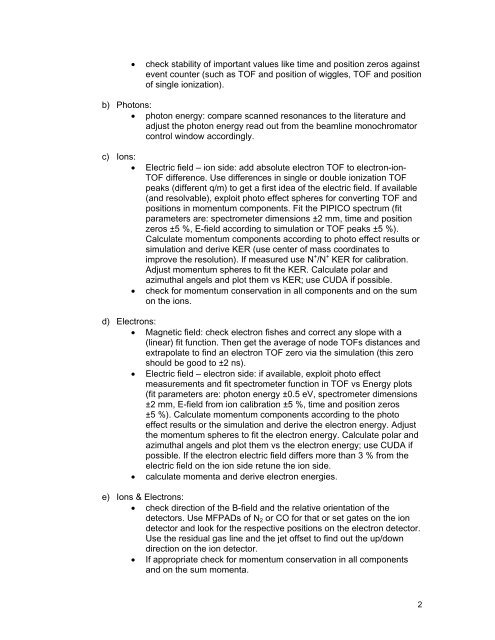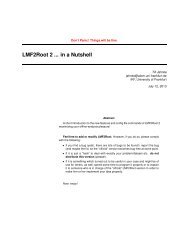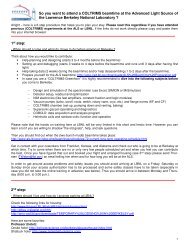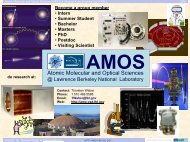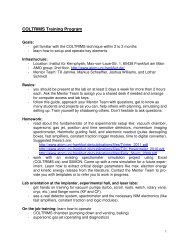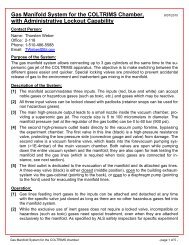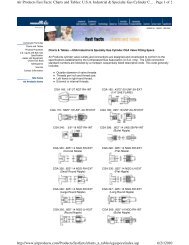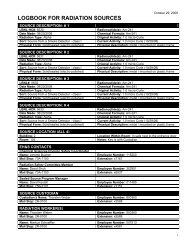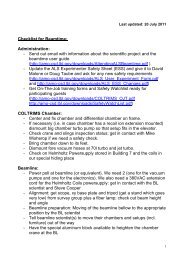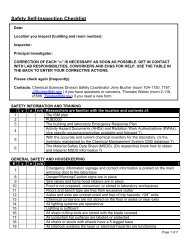Basic Outline of an Analysis of a COLTRIMS Experiment
Basic Outline of an Analysis of a COLTRIMS Experiment
Basic Outline of an Analysis of a COLTRIMS Experiment
Create successful ePaper yourself
Turn your PDF publications into a flip-book with our unique Google optimized e-Paper software.
• check stability <strong>of</strong> import<strong>an</strong>t values like time <strong>an</strong>d position zeros against<br />
event counter (such as TOF <strong>an</strong>d position <strong>of</strong> wiggles, TOF <strong>an</strong>d position<br />
<strong>of</strong> single ionization).<br />
b) Photons:<br />
• photon energy: compare sc<strong>an</strong>ned reson<strong>an</strong>ces to the literature <strong>an</strong>d<br />
adjust the photon energy read out from the beamline monochromator<br />
control window accordingly.<br />
c) Ions:<br />
• Electric field – ion side: add absolute electron TOF to electron-ion-<br />
TOF difference. Use differences in single or double ionization TOF<br />
peaks (different q/m) to get a first idea <strong>of</strong> the electric field. If available<br />
(<strong>an</strong>d resolvable), exploit photo effect spheres for converting TOF <strong>an</strong>d<br />
positions in momentum components. Fit the PIPICO spectrum (fit<br />
parameters are: spectrometer dimensions ±2 mm, time <strong>an</strong>d position<br />
zeros ±5 %, E-field according to simulation or TOF peaks ±5 %).<br />
Calculate momentum components according to photo effect results or<br />
simulation <strong>an</strong>d derive KER (use center <strong>of</strong> mass coordinates to<br />
improve the resolution). If measured use N + /N + KER for calibration.<br />
Adjust momentum spheres to fit the KER. Calculate polar <strong>an</strong>d<br />
azimuthal <strong>an</strong>gels <strong>an</strong>d plot them vs KER; use CUDA if possible.<br />
• check for momentum conservation in all components <strong>an</strong>d on the sum<br />
on the ions.<br />
d) Electrons:<br />
• Magnetic field: check electron fishes <strong>an</strong>d correct <strong>an</strong>y slope with a<br />
(linear) fit function. Then get the average <strong>of</strong> node TOFs dist<strong>an</strong>ces <strong>an</strong>d<br />
extrapolate to find <strong>an</strong> electron TOF zero via the simulation (this zero<br />
should be good to ±2 ns).<br />
• Electric field – electron side: if available, exploit photo effect<br />
measurements <strong>an</strong>d fit spectrometer function in TOF vs Energy plots<br />
(fit parameters are: photon energy ±0.5 eV, spectrometer dimensions<br />
±2 mm, E-field from ion calibration ±5 %, time <strong>an</strong>d position zeros<br />
±5 %). Calculate momentum components according to the photo<br />
effect results or the simulation <strong>an</strong>d derive the electron energy. Adjust<br />
the momentum spheres to fit the electron energy. Calculate polar <strong>an</strong>d<br />
azimuthal <strong>an</strong>gels <strong>an</strong>d plot them vs the electron energy; use CUDA if<br />
possible. If the electron electric field differs more th<strong>an</strong> 3 % from the<br />
electric field on the ion side retune the ion side.<br />
• calculate momenta <strong>an</strong>d derive electron energies.<br />
e) Ions & Electrons:<br />
• check direction <strong>of</strong> the B-field <strong>an</strong>d the relative orientation <strong>of</strong> the<br />
detectors. Use MFPADs <strong>of</strong> N2 or CO for that or set gates on the ion<br />
detector <strong>an</strong>d look for the respective positions on the electron detector.<br />
Use the residual gas line <strong>an</strong>d the jet <strong>of</strong>fset to find out the up/down<br />
direction on the ion detector.<br />
• If appropriate check for momentum conservation in all components<br />
<strong>an</strong>d on the sum momenta.<br />
2


